
views
Calculating Mechanical Power as a Function of Work

Calculate work. In mechanical physics, work is the amount of force needed to move something over a selected distance. The formula for work is: Work = Force ∗ Distance {\displaystyle {\text{Work}}={\text{Force}}*{\text{Distance}}} {\text{Work}}={\text{Force}}*{\text{Distance}} To understand this concept, think about a 100 pound cement block. Moving that block 2 feet requires twice as much work as moving the same block 1 foot. This is also the same amount of work required to move a 200 pound block for a distance of 6 inches (1/2 a foot).

Define mechanical power. Power is the rate at which work is performed over time. The basic formula for defining power is: Power = Work Time {\displaystyle {\text{Power}}={\frac {\text{Work}}{\text{Time}}}} {\text{Power}}={\frac {{\text{Work}}}{{\text{Time}}}} Think again about the 100 pound cement block. Moving that block 2 feet in 10 seconds requires twice as much power as moving the same block for the same distance in 20 seconds. Moving the same object faster requires more power.
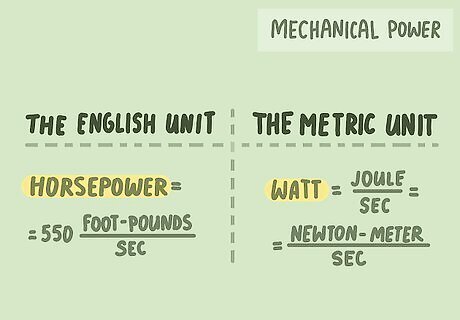
Determine the units you're using for work and power. You need to determine whether you are measuring work and power in traditional English units or in metric units. The English unit for work is the “foot-pound.” This comes from multiplying the distance measured in feet by the force measured in pounds. The unit for power comes from dividing by time, in seconds. The power unit is the “foot-pound per second.” A more familiar term is the “horsepower,” which is defined as 550 foot-pounds per second. 1 Horsepower = 550 foot-pounds sec. {\displaystyle 1{\text{ Horsepower}}=550{\frac {\text{foot-pounds}}{\text{sec.}}}} 1{\text{ Horsepower}}=550{\frac {{\text{foot-pounds}}}{{\text{sec.}}}} The metric unit for work is a joule. A joule is equal to one Newton-meter, which is the amount of work needed to move a 1 Newton force a distance of 1 meter. When you divide work by time, you get power, measured in units of joules per second. This is also called a Watt. 1 Watt = 1 Joule Sec. = 1 Newton-Meter Sec. {\displaystyle 1{\text{ Watt}}=1{\frac {\text{ Joule}}{\text{ Sec.}}}=1{\frac {\text{ Newton-Meter}}{\text{ Sec.}}}} 1{\text{ Watt}}=1{\frac {{\text{ Joule}}}{{\text{ Sec.}}}}=1{\frac {{\text{ Newton-Meter}}}{{\text{ Sec.}}}}
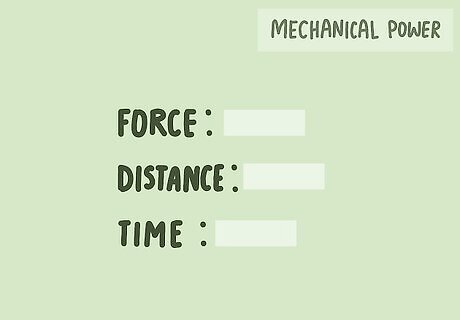
Collect the available data. Whether you are solving a physics problem in class or are actually calculating power from a real-world application, you need to collect certain information first. You can learn the information that you need by reviewing the measurement units. For example, suppose you want to calculate in the following problem: A student doing chin-ups lifts his 150 lb. body a distance of 1.5 feet in 2 seconds. How much power is the student exerting? Force = 150 lbs. {\displaystyle {\text{Force}}=150{\text{ lbs.}}} {\text{Force}}=150{\text{ lbs.}} Distance = 1.5 feet {\displaystyle {\text{Distance}}=1.5{\text{ feet}}} {\text{Distance}}=1.5{\text{ feet}} Time = 2 sec. {\displaystyle {\text{Time}}=2{\text{ sec.}}} {\text{Time}}=2{\text{ sec.}}
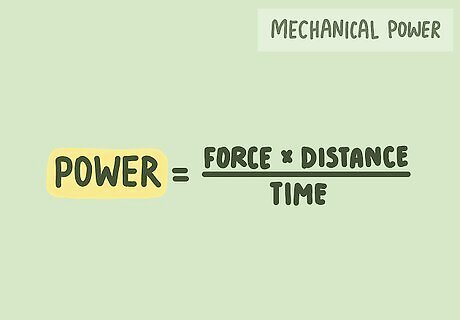
Multiply force by distance and divide by time. Whether in the metric system or the English system, once you have collected the data for the force, the distance and the time, apply them to the formula to find the mechanical power. Power = Force ∗ Distance Time {\displaystyle {\text{Power}}={\frac {{\text{Force}}*{\text{Distance}}}{\text{Time}}}} {\text{Power}}={\frac {{\text{Force}}*{\text{Distance}}}{{\text{Time}}}} Power = 150 lb. ∗ 1.5 feet 2 sec. {\displaystyle {\text{Power}}={\frac {150{\text{lb.}}*1.5{\text{feet}}}{2{\text{sec.}}}}} {\text{Power}}={\frac {150{\text{lb.}}*1.5{\text{feet}}}{2{\text{sec.}}}} Power = 225 ft-lb 2 sec. {\displaystyle {\text{Power}}={\frac {225{\text{ft-lb}}}{2{\text{sec.}}}}} {\text{Power}}={\frac {225{\text{ft-lb}}}{2{\text{sec.}}}} Power = 112.5 ft-lb sec. {\displaystyle {\text{Power}}=112.5{\frac {\text{ft-lb}}{\text{sec.}}}} {\text{Power}}=112.5{\frac {{\text{ft-lb}}}{{\text{sec.}}}} Since 1 horsepower equals 550 ft-lb/sec., this is about equal to one-fifth of a horsepower.
Calculating Mechanical Power as a Function of Velocity
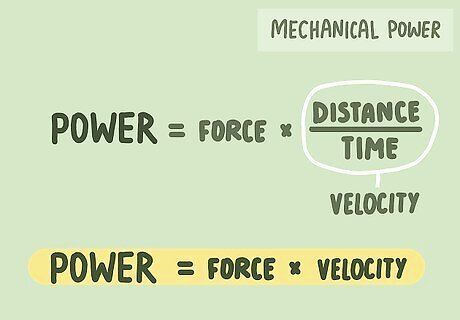
Rewrite the formula for power. The original formula for power focuses on work, as a force times distance, and divides by the time it takes to do that work. Another way to consider the same components is as follows: Power = Force ∗ Distance Time {\displaystyle {\text{Power}}={\text{Force}}*{\frac {\text{Distance}}{\text{Time}}}} {\text{Power}}={\text{Force}}*{\frac {{\text{Distance}}}{{\text{Time}}}} By grouping the terms differently, in this way, you should recognize that Distance Time {\displaystyle {\frac {\text{Distance}}{\text{Time}}}} {\frac {{\text{Distance}}}{{\text{Time}}}} is another way of representing velocity. Therefore, you can conclude that: Power = Force ∗ Velocity {\displaystyle {\text{Power}}={\text{Force}}*{\text{Velocity}}} {\text{Power}}={\text{Force}}*{\text{Velocity}} Consider a 2000 pound car. Moving that car at a speed of 50 miles per hour takes twice as much power as moving the same car at a speed of 25 miles per hour.
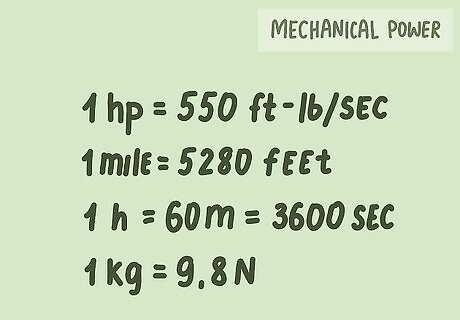
Convert the units as needed. The units of power are generally calculated in either Watts, which are Joules/sec. or Newton-meters per second, or in horsepower (hp) or foot-pounds per second. Recall that 1 hp = 550 ft-lb/sec. If your situation or problem presents data in different units, you will have to convert. Some of the most useful conversion factors are: 1 mile = 5280 feet 1 hour = 60 minutes = 3600 seconds 1 kg = 9.8 N (force) For the moving car problem, the data is provided in miles, hours and pounds. You need to convert 50 miles into 50*5280=264,000 feet, and convert hours into 3600 seconds. Then you can restate the problem as calculating the power of moving a 2000 pound car at a velocity of 264,000/3,600 = 73.33 feet per second.

Multiply the force by the velocity. When your data is in the correct format, you can calculate power as the product of force times velocity. For the car problem, this becomes: Power = Force ∗ Velocity {\displaystyle {\text{Power}}={\text{Force}}*{\text{Velocity}}} {\text{Power}}={\text{Force}}*{\text{Velocity}} Power = 2000 Pounds ∗ 73.33 feet sec {\displaystyle {\text{Power}}=2000{\text{Pounds}}*73.33{\frac {\text{feet}}{\text{sec}}}} {\text{Power}}=2000{\text{Pounds}}*73.33{\frac {{\text{feet}}}{{\text{sec}}}} Power = 146 , 660 foot-pounds sec {\displaystyle {\text{Power}}=146,660{\frac {\text{foot-pounds}}{\text{sec}}}} {\text{Power}}=146,660{\frac {{\text{foot-pounds}}}{{\text{sec}}}} You can report this as the car’s power, or convert to horsepower by dividing by 550. Power = 146 , 660 / 550 = 266.65 horsepower {\displaystyle {\text{Power}}=146,660/550=266.65{\text{ horsepower}}} {\text{Power}}=146,660/550=266.65{\text{ horsepower}} The engine exerted 266.65 horsepower in moving the 2000 pound car at a velocity of 50 mph.
Calculating Electrical Power
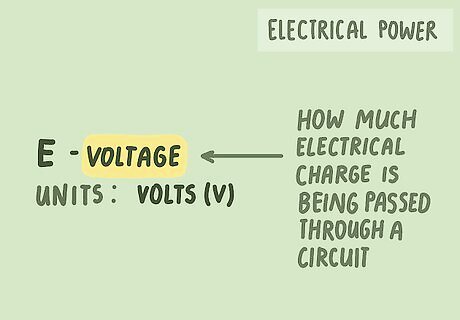
Record the circuit’s voltage. A circuit’s voltage is analogous to the force applied in a mechanical movement. The voltage tells you how much electrical charge is being passed through a circuit. Just as moving a heavy block of cement requires great mechanical power, moving a high voltage requires a large electrical power output. Voltage is measured in units calls volts, abbreviated V. In equations, the voltage is represented by the symbol E. If you are reading a circuit diagram, the voltage will be written somewhere on the diagram. If you are building an actual circuit, the voltage is the power coming from the battery source. For example, a single 9 volt battery provides 9 volts to the circuit.
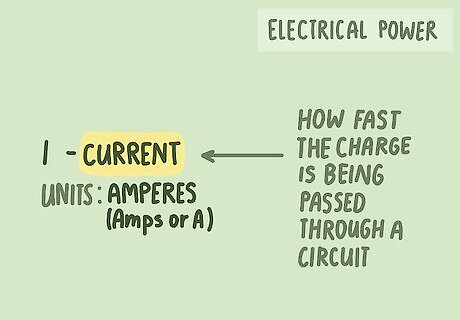
Record the circuit’s current. The current of an electrical circuit is analogous to the velocity applied in a mechanical movement. The current tells you how fast the charge is being passed through the circuit. Current is measured in units called Amperes, abbreviated as Amps or just A. In calculations, current is symbolized by the capital letter I. Current can be measured directly using a reader called an ammeter. Alternatively, the problem you are working on may simply provide the number of Amps in the circuit. For example, a circuit that has a current of 4 Amps is moving the charge twice as quickly as a circuit with a current only 2 Amps.
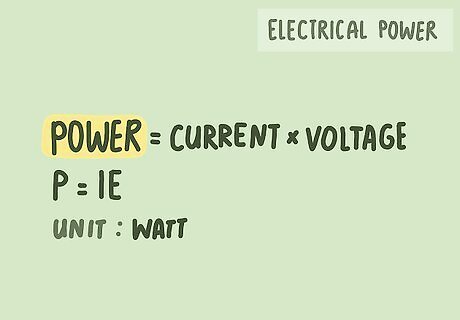
Define electrical power. Just as power can be defined in the mechanical sense as the amount of work exerted over time, electrical power is also an amount of work exerted over time. However, with electrical power, the work that is calculated is the work of moving electrons through an electrical circuit. A circuit that moves more electrons or moves them more quickly will be defined as having greater power. The unit of electrical power is the Watt. It is calculated as follows: Power = Current ∗ Voltage {\displaystyle {\text{Power}}={\text{Current}}*{\text{Voltage}}} {\text{Power}}={\text{Current}}*{\text{Voltage}} P = I E {\displaystyle P=IE} P=IE
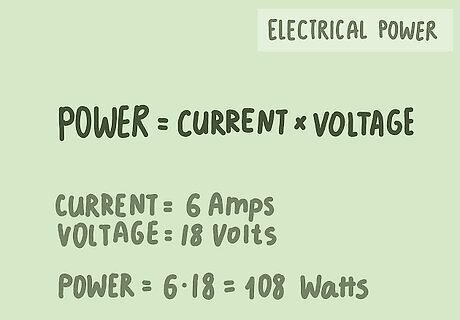
Calculate the power of a circuit. Suppose a given electrical circuit has a current of 6 Amps and a charge of 18 volts. To calculate the power in the circuit, you need to multiply as follows: Power = Current ∗ Voltage {\displaystyle {\text{Power}}={\text{Current}}*{\text{Voltage}}} {\text{Power}}={\text{Current}}*{\text{Voltage}} Power = 6 ∗ 18 = 108 W a t t s {\displaystyle {\text{Power}}=6*18=108Watts} {\text{Power}}=6*18=108Watts Ned Mohan Ned Mohan, Electrical Machines and Power Electronics Expert Figuring out power output is key to analyzing any electrical system or gadget. For a DC circuit with voltage V and current I, it's just P=VI. But with AC circuits, you've got to account for impedances that shift voltage and current out of sync. By multiplying the RMS voltage, RMS current, and power factor cosine theta, you get the real power used in watts. This works for motors, generators, transformers—anything AC. Grasping these basics lets you properly design systems and size components for the power you need.



















Comments
0 comment